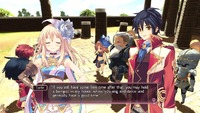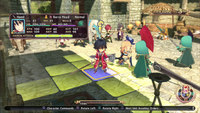|
|
 |
PLATFORM
|
PS3
|
BATTLE
SYSTEM
|
 |
INTERACTION
|
 |
ORIGINALITY
|
 |
STORY
|
 |
MUSIC
& SOUND
|
 |
VISUALS
|
 |
CHALLENGE
|
Adjustable
|
COMPLETION
TIME
|
60-80 Hours
|
|
OVERALL

|
+
Fun and flexible battle
system
+
Large party right from the
start
+
Lots of optional battle
challenges
-
Tortuously paced story
-
Can't skip, only fast forward
cutscenes
-
Plot and battles never quite
mesh
|
Click
here for scoring
definitions
|
|
|
Tears to
Tiara II: Heir of the Overlord is a strategy
RPG from Aquaplus and Sting. More accurately
described as a combination of a visual novel and
SRPG, Tears to Tiara II pairs lengthy
story sequences with deep strategic combat against
the backdrop of a fantasy take on Roman-era
Europe. Sadly, the pairing doesn't work out very
well in the end. The plot is poorly paced,
becoming way more verbose than necessary and
endlessly delving into drawn out backstory without
much relevance to current events. Battles are
integrated poorly as well, with overly long
stretches without combat and transitional scenes
that don't mesh with the corresponding battle. If
not for the high quality of the battle system and
some fun characters, these issues would easily
crush the game. Thankfully, for those with a high
degree of patience, there is a good deal of fun to
be eked out of Tears to Tiara II.
The story begins in
Hispania, this fantasy world's version of Spain.
The Divine Empire is busy enslaving the people and
destroying the temples to old gods. The game
starts out with a decent hook, as the young heir
of the former ruling family of Hispania, Hamil,
fights to save the life of a girl claiming to be a
goddess. Hamil seemingly transforms into a more
powerful being and takes out many enemies, as he
kicks off a rebellion against the Empire. The game
then flashes back to prior events, and this is
when the pace of Tears to Tiara II begins
to unravel. With only a few tutorial-style battles
to break things up, the first five to six hours
move at a glacial pace back to that opening scene.
There is backstory to cover about Hamil and his
father's failed rebellion, the goddess in human
form known as Tarte who has come to help him, and
of course the slowly-building rebellion. The level
of verbosity and superfluous conversation reaches
absurd levels, and many players will be very
thankful that a fast forward button is available.
This is really
a microcosm of the overall pacing issue, though
things do eventually improve when battles are
longer and more frequent to help break things up.
There's nothing particularly wrong with the
overall story of fighting against the Divine
Empire. It touches some more mature wartime
subjects, though never with a great deal of
maturity. The cast is entertaining, and there are
some lighthearted and enjoyable moments, though
sometimes these seem to be inappropriately close
to the more somber ones. The problem is even the
most basic conversation or plot element seems to
require an agonizing amount of dialogue. There is
also a tendency to veer off into extended and
completely unnecessary backstory that adds nothing
to the main plot. The way the sequences are told
doesn't help either. Generally, still images are
used, often for long amounts of time before a
different scene is shown. This makes many segments
feel even more slow and stale. Many do use the
battle engine to show characters moving and
acting, and these feel noticeably stronger, but
are seldom used in the longer story sequences.
It's unfortunate, as all the makings for a fun
story are there.
 Can we
just get to the fighting
already? Can we
just get to the fighting
already? |
|
Thankfully, the
battle system doesn't suffer from as many issues.
It has a pretty basic setup where player and enemy
turns are segmented, and terrain is pretty simple
with no elevation to worry about. The engine is
3D, but pulled back to where players should never
any issues getting a good view of the battlefield.
The character models all have a nice look to them,
as if they were originally 16-bit sprites forcibly
pulled into the new millennium. Generally the goal
is simply to wipe out the enemy force in a battle,
but there are alternate objectives in each battle,
some of which offer bonuses. Nicest of all, once
beyond the quick tutorial battles of the game's
torturous first chapter, the player is given a
large party right off the bat and the gloves are
taken off. Players have to use Hamil and Tarte in
specific battles throughout the story, but which
characters players focus on is otherwise left
open.
Making this
large party aspect more fun is the ability to swap
characters in and out mid-battle. In every battle
there will be an elephant pulling the cart used
for this purpose. This means players can move the
cart to strategic positions to help get
reinforcements quicker, though if the cart is
defeated no further reinforcements can take place
for the remainder of that battle. Further adding
flexibility is a number of options that allow
tweaking the difficulty to a player's liking. One
of these is the ability to simply switch between
three difficulties at any time in battle.
Secondly, after falling in battle players can
simply restart, keeping all the experience gained
in the failed attempt to make the next try a bit
easier. The biggest, however, is the ability to
rewind to the start of any previous turn with no
cost or penalty whatsoever. This allows trying out
different strategies to see how they work, undoing
disastrous turns without restarting battle, and
other options that really take away a lot of the
frustration that SRPGs can sometimes run into.
Tears to
Tiara II doesn't provide much in the way of
customization outside of equipment and the ability
to learn and equip stat-buffing skills.
Thankfully, the large selection of party members
provides a good mix of classes, and even those
characters that share classes have their own
unique abilities that help ensure there isn't much
overlap. The two main characters, Hamil and Tarte,
can also transform into more powerful forms for
two turns when after a certain amount of time
passes in battle. All characters also build up a
special charge meter, which can be used to buff
abilities or gain extra attacks. Despite no other
real-time elements in the game, these extra hits
will only occur if the player hits a button when
prompted during the attack animation. Players have
a wide variety of options in combat to work with,
and there isn't normally any one particular way to
finish any given battle.
 Don't
you dare mess with my elephant! Don't
you dare mess with my elephant!
|
|
In addition to
strategically using character skills, several
other factors also come into play. The game
features a number of different elements such as
the fire, wind, holy, etc. which characters have
an affinity to, and certain skills and spells use
as well. Which elements are currently buffed or
weakened is shown by a wheel-shaped indicator that
changes each turn. Players must pay close
attention to this, along with the innate element
of enemies, to effectively use skills. As
nicely as this is implemented, a few other battle
elements don't work quite so well. These include
traps, which are hidden throughout many maps and
cause a character to take damage and end their
turn when they move onto them. Though they equally
affect enemies and allies, they mostly prove to be
annoying, with no real way to track them down
outside of trial and error. It's the one instance
where players may be tempted to use the turn
rewind system, though their effect isn't bad
enough to turn the tide of a battle towards
defeat. In addition to this, there are also
certain skills characters can only use before
moving, which would suggest that they're more
powerful. In actuality, aside from some healing
spells they don't tend to be any more powerful
than any other skill. All said, the issues are
mostly minor and combat is deep and fun, and quite
challenging for those that want it to be.
Though the highlight
of the game may be its battle system, that system
often feels at odds with the story. Natural spots
for battles often pass by without an inkling of
combat, only to have battles forced into an odd
location just for the sake of the plot. That said,
conversations and plot development during battle
is a rarity. This disjointedness might be
explained by the presence of two different
developers, making it seem as if combat and story
were handled independently without taking the
other side into consideration.
Strategy RPGs
and visual novels seem like a suitable match given
the history of great stories in this sub-genre. A
fine union may still be possible, but Tears to
Tiara II is certainly not it, and not
because of a lackluster story. The two elements
never quite mesh together consistently.
Thankfully, the battle system is a lot of fun with
only a few annoyances. After a torturous first
chapter things open up, a large party becomes
available, and players can delve into optional
elements in battle that will offer a challenge to
SRPG fans. It's not that Tears to Tiera II
can't be fun, but it's just that there is so much
padding that only the most patient of gamers will
be able to find that enjoyment.
Review
Archives
|









